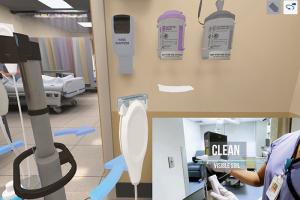BayCare Health engages patients with Alexa devices

The Aiva voice assistant integrates with Amazon’s voice assistant to improve communication between patients and care teams.
Image courtesy of BayCare Health
BayCare Health has deployed Amazon’s voice assistant (Alexa) devices across 2,600 patient rooms in 14 Tampa Bay, Fla.-area hospitals, one of the largest such deployments for a U.S. health system. The devices connect with Aiva, a voice-powered virtual health assistant that works with Alexa and Google solutions.
Today, Aiva allows patients to control the hospital room television via Alexa as part of BayCare’s phase one deployment. Where the facility’s infrastructure allows, the health system is adding in-room voice control for lighting, powered blinds and room temperature. However, the next priority is to connect patients directly to care teams through Alexa for improved service and communication.
“We are in the process of developing and rolling out additional features to enhance communication between patients and our care teams,” says Craig Anderson, BayCare director of innovation. “Our plan is to standardize these offerings and deploy them across all hospitals early next year.”
The Aiva platform is able to interpret requests and send them to the right person, connecting the patient to their care team through their workplace smartphone. “The patient can simply ask Alexa for things they need like a blanket or a glass of water,” Anderson says.
The voice-powered solution was piloted at St. Joseph’s Hospital and Winter Haven Hospital in 2019 before being deployed across St. Joseph’s Hospital-North. Through these pilots, the health system was able to address potential hurdles as they arose.
“A key step to implementing new technology is educating all levels of the organization to be sure everyone understands how patients will benefit from the innovation,” Anderson says. “And while we were excited to move forward, we have had to proceed with extra caution due to the COVID-19 pandemic. It took careful planning to be sure our work was done safely as patient rooms were available.”
To ensure patient privacy and network security, the rollout also required the information services team to move the devices onto a reserved portion of the BayCare network.
Patients were highly satisfied with the technology in surveys during the pilot, Anderson says. As he puts it, “This is bringing consumer-friendly technology into the medical space.”




